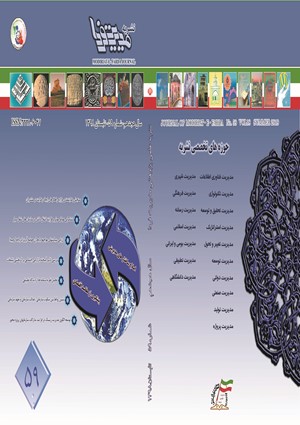ارائه مدل برنامه ریزی ریاضی چند هدفه برای انتخاب تأمین کننده در شرایط تخفیف
محورهای موضوعی : مدیریت صنعتیعباس شول 1 , علی یعقوبی پور 2 , لاله عباسلو 3
1 - دانشگاه ولی عصر(عج) رفسنجان
2 - دانشگاه آزاد
3 - دانشگاه آزاد
کلید واژه: انتخاب تأمین کننده, قابلیت اطمینان, برنامهریزی چندهدفه, آرمان فازی, تصمیم¬, گیری فازی,
چکیده مقاله :
در پژوهش حاضر مسأله انتخاب تامین کننده از یک منظر جدید فرمول بندی و حل می شود. بدین منظور کمینه سازی هزینه و کمینهسازی زمان تحویل و بیشینهسازی قابلیت اطمینان به عنوان اهداف مسئله در نظر گرفته شده است. هزینه خرید در شرایط تخفیف، هزینه سفارش، هزینه حمل، هزینه کمبود و هزینه نگهداری، اجزاء تشکیل دهنده تابع هدف هزینه می باشند. در این تحقیق از طراحی قابلیت اطمینان (پایایی) در سیستم های موازی برای انتخاب تأمین کننده الگوبرداری شده است به طوری که مجموعه تأمینکنندگان به عنوان یک سیستم و هر تأمینکننده به عنوان یک جزء در نظر گرفته شده است. پس از مدلسازی ریاضی مسأله، توابع هدف، به صورت آرمان های فازی توصیف شده اند و از یک رویکرد تصمیم گیری فازی برای بازنویسی مدل سه هدفه پیشنهادی به صورت مدلی تک هدفه استفاده گردیده است. تولید یک جواب نهایی به جای مجموعه ی جوابهای کارای پارتو، از مزیتهای روش پیشنهادی است که مانع سردرگمی تصمیم گیرنده است. به منظور توصیف عملکرد و کاربرد بالقوه روش پیشنهادی، مسأله انتخاب تامین کننده با داده های واقعی حل گردید.
In the present study, the supplier selection problem from a new perspective is formulated and solved. For this purpose, minimizing cost and minimizing delivery time and maximizing reliability are considered as objectives of the problem. The purchasing cost in discounted status, the order cost, the transportation cost, the shortage cost and the carrying cost, the components forming the cost objective function. In this research, the design of reliability in parallel systems is benchmarked for supplier selection, so that the supplier's set is considered as a system and each supplier as a component. After mathematical modeling of the problem, the objective functions are described as fuzzy goals and a fuzzy decision approach has been used to rewrite the proposed three-objective model as a single-objective model. The production of a final solution rather than a set of Pareto's solutions is one of the advantages of the proposed method, which prevents decision-making confusion. In order to describe the function and potential application of the proposed method, the supplier selection problem with the actual data was solved.
[1] Mendoza, A. (2007). Effective methodologies for supplier selection and order quantity allocation.
[2] Aissoaoui, N. (2007)." Supplier selection and order lot sizing modeling: A review". Journal of Comouter and Operation Research, 34, 3516-3540.
[3] Lukinskiy,V. Lukinskiy,V.Churilov, R.(2014). "Problems Of The Supply Chain Reliability Evaluation". Transport and Telecommunication, volume 15, no,2,120-129
[4] Burkovskis, R. J. T. (2008). Efficiency of freight forwarder's participation in the process of transportation. 23(3), 208-213
[5] MIAO, Z.-w., & WU, X.-y. J. E. M. J. (2009). Supply Chain Management Based on Corporate Social Responsibility——Evaluation System and Performance Testing [J].
[6] Van Nieuwenhuyse, I., & Vandaele, N. J. I. J. o. P. E. (2006). The impact of delivery lot splitting on delivery reliability in a two-stage supply chain. 104(2), 694-708
[7] Quigley, J., Walls, L. J. R. E., & safety, S. (2007). Trading reliability targets within a supply chain using Shapley's value. 92(10), 1448-1457
[8] Hsu, c.i, Li, h.c,(2011). "Reliability evaluation and adjustment of supply chain network design with demand fluctuations". Int. J. Production Economics. 132, 131-145.
[9] Pasandideh, S. H. R., Niaki, S. T. A., & Asadi, K. J. E. S. w. A. (2015). Optimizing a bi-objective multi-product multi-period three echelon supply chain network with warehouse reliability. 42(5), 2615-2623.
[10] Liang, T. F. Chen, H. W. (2008). "Application f fuzzy sets to manufacturing/distribution planning decision with multi-product and multi-time period in supply chains". Expert Systems with Applications, 36, 3367-3377.
[11] Aliev, R. A., Fazlollahi, B., Guirimov, B. G. Aliev, R. R. (2007). "Fuzzy-genetic approach to aggregate production-distribution planning in supply chain management". Informaton Sciences, 177, 4241-4255.
[12] Irfan, D., Xiaofei, X., & Chun, D. S. J. I. A. J. o. I. T. (2008). A SCOR Reference Model of the Supply Chain Management System in an Enterprise. 5(3).
[13] Selim, H., Ozkarahan, I. (2008). "A supply chain distribution network design model: An interactive fuzzy goal programming-based solution approach". International Journal of Advanced Manufacturing technology, 36, 401-418.
[14] Bilgen, B. (2010). "Application of fuzzy mathematical programing approach to the production allocation and distribution supply chain network problem". Expert system with application, 37, 4488-4495.
[15] Shi,J. Zhang. G., Sha, J.,(2012). "A Lagrangian based solution algorithm for a build-to-order supply chain network design problem," Advances in Engineering Software, vol. 49, pp. 21-28.
[16] Tsao,Y,C., Lu,J,C.(2012). "A supply chain network design considering transportation cost discounts," Transportation Research Part E: Logistics and Transportation Review, vol. 48, pp. 401-414.
[17] Bashiri.M, Badri. H.Talebi,J.(2012) "A new approach to tactical and strategic planning in production–distribution networks," Applied Mathematical Modelling, vol. 36, pp. 1703-1717.
[18] Snyder, L.V.,(2003)."Supply chain robustnes and reliability: models and algorithms (PHD Tesis), in Dept. of Industrial and Engineering and Management Sciences. Northwestern University: Evanston, IL,.
[19] Eiselt, H., Gendreau, M., Laporte, G. (1996). " Optimal location of facilities on a network with an unreliable node or link". Information processing letters. 58(2):71-74.
[20] Bellman, R.E. Zadeh, L.A.(1970). Decision making in a fuzzy environment, manag. sci.17-141-146


